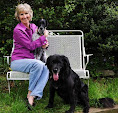I hate puppy mills, and have for as long as I’ve been aware
of their existence…at least in theory. The idea that anyone, much less
thousands of people, would treat man’s best friend as nothing more than a crop
or a widget to be mass produced on as large a scale as possible is almost
beyond my comprehension. And images captured by undercover photographers of
crates or cages stacked one on top of another, with the parents—or “breeding
stock”—of those cute little puppies destined for pet stores around the country
sitting in abject misery, their urine and feces dripping unheeded on the bodies
of those below are burned forever in my brain. It’s hard to believe that anyone
could look at such images and deny that puppy mills breed misery for those
dogs.
But the misery doesn’t stop there.
Puppy mills hurt people as well as dogs. They hurt the people
who, in their innocence or ignorance, have paid hundreds or even thousands of
dollars for an “AKC registered” puppy they believe is healthy and sound only to
discover their little bundle of joy suffers from a congenital or genetic
medical problem. Rife with inbreeding
and with profit as the only goal, puppy mills are breeding grounds for all
manner of diseases and other medical conditions…conditions that can cost
thousands of dollars to treat and may even end in the death of the puppy.
But
the misery doesn’t stop there.
Puppy mills hurt those of us involved in animal rescue and
welfare because we’re the people who have to clean up the “mess” they create. We
end up taking in, caring for, and trying to rehabilitate the victims of this
vicious system. We try our best to treat the eye, ear, and skin infections; pull
the abscessed and rotten teeth; remove the untreated injured eyes; amputate the
damaged, deformed limbs; and try to cure any other diseases. Sadly, our best
sometimes isn’t enough.
The shelter I work at is all too frequently asked to rescue,
rehabilitate, and rehome victims of the puppy mill system. Recently, we took in
20 adult Chihuahuas and 4 Shar-Peis rescued from an Ohio puppy mill. In
addition to the physical ailments described above, virtually all the dogs
displayed behaviors characteristic of dogs who have been confined to small
spaces and received little to no positive human interaction. They circled
endlessly even in large dens, cowered at the back of their dens, or growled
when approached. Even those that seemed interested in people didn’t seem to understand
how to engage in normal interspecies fashion.
Given time—lots of it—behavioral intervention, and love,
most of these dogs will settle into lives far better than anything they’ve ever
known. But, sadly, not all of them will get the chance.
A few of the dogs who
walked—or were carried—through our door were beyond our ability to help. One, a
6-year-old female Shar-Pei, will haunt me forever. She arrived emaciated and
suffering from mange …a walking, hairless bag of bones. And beyond all that, an
untreatable autoimmune disease was systematically killing off her red blood
cells. The only act of kindness we could give her was a humane, peaceful end to
a miserable existence.
Several of my colleagues and I sat with her, stroking her
patchy fur and telling her what a good girl she was while a veterinarian
injected the sedative that allowed her to drift easily asleep before
administering the shot that stopped her heart.
Afterwards, I returned to my office and wept.








